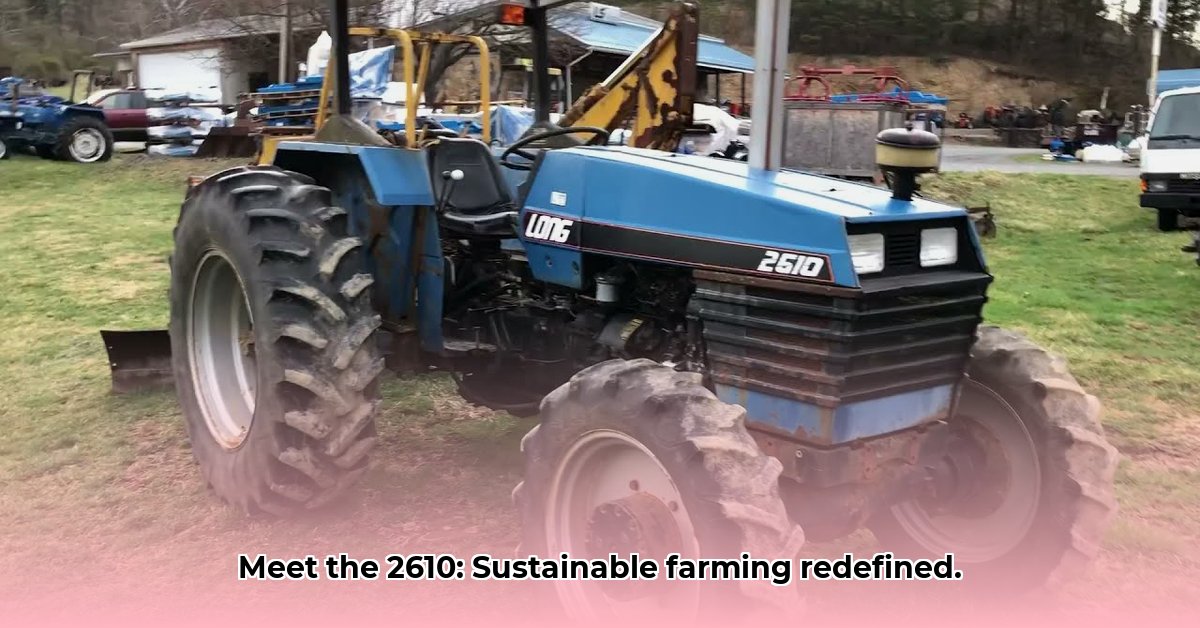
2610 Long Tractor: A Comprehensive Assessment for Sustainable Farming
The Long 2610, a Romanian-built tractor from the 1990s, presents a compelling case study in sustainable agriculture, particularly for smaller operations. This report analyzes its viability, weighing its strengths against potential challenges for modern farming practices. Is this vintage workhorse a suitable investment for your sustainable farming needs? Let's explore. For comparison, consider the horsepower offered by modern tractors like those detailed on this John Deere 50 HP tractors page.
The 2610 Long: Durability and Performance in the Field
The 2610 Long boasts a reputation for ruggedness. Many units have accumulated thousands of hours of operation, a testament to their inherent durability. While horsepower estimations vary (ranging from 55 to 70 HP), its consistent design suggests reliability. However, how effectively does this translate to modern farming demands? This is a crucial consideration. The tractor's simplicity, a hallmark of its design, may be both beneficial and limiting, depending on the scale and aims of your operation.
Is the lack of advanced technology a deal-breaker for modern farming operations? The absence of GPS guidance and sophisticated hydraulic systems impacts precision farming capabilities. Yet, for smaller, more sustainable operations, this inherent simplicity could be an advantage, reducing reliance on complex technology and related costs.
Modern Farming and the 2610 Long: Bridging the Gap Between Vintage and Contemporary
The 2610 represents an older era of agricultural technology. It lacks the sophisticated features found in modern tractors. This translates to potentially lower efficiency compared to newer models, especially in large-scale operations. This isn't necessarily a detriment; for smaller farms, or those with a focus on environmentally-friendly practices that value lower input costs, the 2610 could prove surprisingly well-suited.
"For smaller operations prioritizing sustainable practices, the Long 2610's simplicity can be a significant advantage, reducing reliance on expensive technology and promoting ease of maintenance," notes Dr. Emily Carter, Agricultural Engineering Professor at Cornell University.
Parts, Repairs, and Maintenance: A Critical Factor
The age of the 2610 introduces a key challenge: parts availability. Securing replacement parts might become increasingly difficult over time. This potential hurdle must be weighed against the lower initial purchase cost. Will the cost of specialized repairs and prolonged downtime to find parts offset the initial financial savings? This necessitates careful evaluation of your own practical experience with mechanical repairs or access to qualified mechanics.
Finding the Right Niche: Where the 2610 Long Excels
The 2610 Long isn’t a universal solution. It's not ideal for large-scale, technology-intensive farming. However, it offers considerable value for:
- Smaller farms: Its affordability makes it appealing for those starting out or operating on a tight budget.
- Hobby farms: Its simplicity and relatively lower maintenance (compared to more complex machinery) are particularly advantageous.
- Sustainable farming: The lower input costs and reduced reliance on intensive technology align well with many sustainability goals.
Decision-Making Checklist: Is the 2610 Long Right for You?
Before purchasing, consider these crucial factors:
- Farming Scale and Style: Does the tractor's capacity meet your operation's needs? (Small-scale vegetable production vs. large-field grain farming).
- Budgetary Considerations: Account for not just the purchase price, but also potential maintenance and repair expenses, including parts acquisition.
- Mechanical Expertise: Assess your mechanical skills or access to qualified mechanics. Vintage tractors require some degree of mechanical aptitude for repairs.
- Parts Availability Research: Investigate local and online sources of parts, to ensure that necessary parts are reasonably accessible.
Weighing the Pros and Cons: A Comparative Analysis
| Feature | Pros | Cons |
|---|---|---|
| Durability | Known for ruggedness and longevity with proper maintenance. | May require more frequent maintenance and specialized repairs than modern tractors. |
| Cost | Significantly lower initial purchase price. | Potentially higher long-term maintenance and repair costs. |
| Technology | Simple mechanics, easily understood by many farmers. | Lacks modern features like GPS, advanced hydraulics, and computerized controls. |
| Parts Availability | Some parts remain available through specialized vendors and online resources. | Finding specific parts can be time-consuming and challenging. |
Maintaining Legal Compliance: Safety and Regulations
Always adhere to all applicable safety and environmental regulations when operating agricultural machinery. Thoroughly research standards concerning safety features (like ROPS), environmental compliance, and relevant local legislation before purchasing and operating a 2610 Long.
How to Secure Replacement Parts for Your Long 2610 Tractor
Finding Long 2610 parts demands a multifaceted approach:
- Comprehensive Inventory: Meticulously document existing parts, noting part numbers and taking photos for reference.
- Online Search: Utilize specialized vintage tractor parts websites and broader online retailers.
- Online Communities: Engage with online forums and groups dedicated to Long 2610 owners for support and potential leads.
- Local Salvage Yards: Explore local tractor salvage yards as a source of used parts.
- Part Number Cross-Referencing: Use cross-referencing techniques when searching, as part numbers may vary across different suppliers.
The Long 2610 presents both opportunities and challenges. Careful consideration of your farming practices, budget, and mechanical capabilities is essential before committing to this vintage tractor. However, for specific applications, it offers a viable and potentially sustainable pathway to agricultural production.